Durable-Goods Orders Increase in September While Core Capital Goods Decline Slightly
New orders for durable goods increased 0.8 percent in September, boosted by a 119.1 percent surge in defense aircraft. Over the past year, orders are up 6.5 percent, reaching the second-highest level on record. Since June 2016, new orders for durables excluding aircraft have been on a strong uptrend, rising 25.6 percent (see chart).
The results for the categories of durable goods shown in the report were mixed in the latest month. Among the industries showing increases, motor vehicles were up 1.3 percent for the month and up 7.1 percent in 2018; machinery orders rose 0.8 percent, pushing the year-to-date gain to 5.8 percent; the catchall “other durables” category was up 0.4 percent in September and is 4.0 percent ahead of last year; and orders for primary metals gained 0.1 percent, putting the year-to-date gain for 2018 versus the first nine months of 2017 at 16.6 percent.
Categories showing declines for September are fabricated metal products, down 0.7 percent in September but up 9.9 percent year to date; electrical equipment and appliances orders, off 0.5 percent in September but up 5.9 percent for 2018; computers and related equipment, off 0.4 percent in September and down 9.9 percent from 2017; and communications equipment, down 0.1 percent for the month but up 7.7 percent for the year.
Within the report on new orders for durable goods are data on new orders for capital equipment, or business investment. This subcategory is particularly important for two reasons. First, business investment can have a major impact on future productivity trends, and productivity is critical for helping offset cost increases as well as raising living standards over the long term. Second, capital-goods orders tend to be early indicators of turns in the business cycle. Real new orders for core capital goods — that is, real nondefense capital goods excluding aircraft — is one of the indicators in AIER’s Leading Indicators index.
On a nominal basis, new orders for core capital goods fell 0.1 percent in September. In a manner similar to the broader durables-goods category, the trend of new orders for core capital goods has been solidly upward since mid-2016, rising 17.4 percent since May 2016 (see chart again). Year to date, new orders for nondefense capital goods excluding aircraft are up 6.6 percent over 2017. However, core capital-goods orders have been essentially flat over the past two months. It’s too early to say that business investment has peaked, especially given the strong underlying fundamentals, but with concerns over trade policy and global economic growth, a case can be made that business leaders may want to defer some investment.
Other data out today include the latest weekly initial claims for unemployment. For the week ending October 20, claims totaled 215,000, up 5,000 from the prior week. The four-week average came in at 211,750, unchanged from the prior week. While claims rose in the latest week, they remain at historically low levels, suggesting the labor market remains very tight.
Today’s data are generally positive overall. The report on durable-goods orders suggests that demand remains strong and that the broader economy is maintaining solid momentum in the second half of 2018. Combined with the latest favorable results of the AIER Leading Indicators index and other data on the labor market, business and consumer sentiment, household and corporate balance sheets, personal income, and corporate sales and earnings, the outlook remains positive with little risk of recession in the coming months and quarters.






